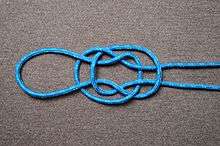Heraklas



Heraklas (Greek: Ἡρακλᾶς) was a Greek physician of the 1st century AD whose descriptions of surgeons' knots and slings are preserved in book 48 of Oribasius' Medical Collections (Ἰατρικαὶ Συναγωγαί, Iatrikai Synagogai) under the title From Heraklas.[1]
Describing them in detail, Heraklas discussed 16 different knots and slings,[1] including the earliest known written account of a string figure.[2] Accompanying illustrations of the knots were added later by Renaissance copyists, but modern analysis of the writings by knot experts has shown many of these early drawings to contain significant errors or misinterpretations.[3]
The knots identified
The current understanding of Heraklas' knots results primarily from analysis and identification by Hjalmar Öhrvall, Lawrence G. Miller, and Cyrus L. Day, although slightly differing interpretations and refinements continue to be made.[1] The table below shows the knots believed to have been described by Heraklas.
| Chapter | Greek name | Translated name | Modern equivalent |
|---|---|---|---|
| I | ertos brokhos | threaded noose | cow hitch |
| II | nautikos brokhos | nautical noose | clove hitch |
| III | khiestos brokhos | crossed noose | overhand noose |
| IV | boukolikos brokhos or sandalios brokhos | pastoral noose or sandal noose | overhand noose variation |
| V | drakon brokhos | dragon noose | overhand noose variation |
| VI | haploun hamma brokhos | single knot noose | (No modern name) |
| VII | lykos brokhos | wolf noose | reef knot[4] |
| VIII | herakleotikon hamma | Hercules knot | reef knot |
| IX | haplous karkhesios brokhos | single jug-sling noose | "true lover's knot" (ABOK #1038) |
| X–XII | diplous karkhesios brokhos | double jug-sling noose | bottle sling |
| XIII | tetrakyklos plinthios brokhos | four-looped rectangular noose | String figure, "The sun clouded over"[5] |
| XIV | epankylotos brokhos | interlooped noose | Tom fool's knot |
| XV | ota brokhos | ears noose | (No modern name) |
| XVI | diankylos brokhos | two-looped noose | (No modern name) |
| XVII | ankhon brokhos | strangler noose | true lover's knot (ABOK #1038)[6] |
| XVIII | hyperbatos brokhos | transposed noose | clove hitch[7] |
See also
Notes and references
- 1 2 3 Hage, J. Joris (April 2008), "Heraklas on Knots: Sixteen Surgical Nooses and Knots from the First Century A.D.", World Journal of Surgery, 32 (4), pp. 648–655, doi:10.1007/s00268-007-9359-x, PMID 18224483, retrieved 2009-07-15
- ↑ Miller, Lawrence G. (1945), "The Earliest (?) Description of a String Figure", American Anthropologist, New Series, 47 (3): 461–462, doi:10.1525/aa.1945.47.3.02a00190
- ↑ Day, Cyrus L. (1967), Quipus and Witches' Knots, Lawrence: University of Kansas Press, pp. 86–89, 101–151
- ↑ Although topologically identical, it is used in a different manner than "VII, Hercules knot". Specifically the bound object (e.g. a limb) is placed in the center of the reef knot.
- ↑ See Caroline Furness Jayne's String Figures and How to Make Them (1906), p. 383, Roth Plate X, 1. and discussion p. 162. N. B. Miller (1945) correctly points out the difference of a single crossing in Jayne's fig. 359, p 161.
- ↑ Although topologically identical, it is used in a different manner than "IX, single jug-sling noose".
- ↑ Although topologically identical, it is used in a different manner than "II, nautical noose".